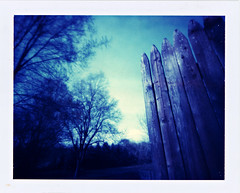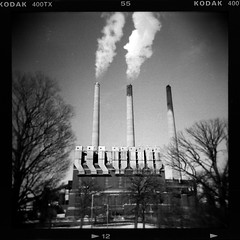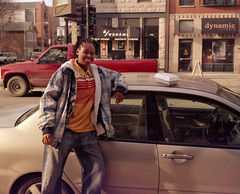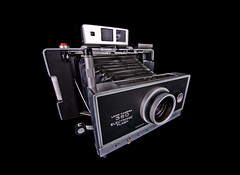Chances are pretty good that if I talked about pinholes with someone, there would be a lot of explaining on my part. It's one of those things that I forget that not everybody knows about, indeed I myself only learned about them in December of 2005. I know this because I attended a talk on pinholes given by Matt Callow, a fellow whose passion for low-tech photography has helped inspire me. Appropriately, Matt and a few mutual friends helped found the Crappy Camera Club not long after our first acquaintance.
Back to the real subject, we're talking about pinhole cameras here. What is a pinhole camera? Basically it's a camera that uses a pinhole, yes a small hole, to project an image onto film. Instead of a lens, that is. I could explain how it works, but that's what Wikipedia is much better at. Basically, just know that it works.
Now, some very interesting things happen as a result of using a pinhole instead of a lens. Expectedly, image sharpness usually degrades a bit, though perhaps not so much as you may think. Images have a tendency to vignette, especially wide-angle on larger formats like the Polaroid shown here. You can get a nice wide angle simply by building a pinhole that way. I made mine out of a jewelry box drawer. No kidding. One of the difficulties you may run into is framing issues, and you could build yourself a viewfinder, which many people do. I'm not so inclined, and I just aim the camera at the subject, guess the framing and exposure, and hope for the best. I try not to overthink it, because pinholes are really about having fun.
Also, you introduce a longer exposure because of how little light makes its way through the pinhole. How long? Well, the photo shown here was taken at about 11 am on a mostly sunny day. I held the shutter open for 12 seconds, and the film speed was 80. That's a long time, but appropriate because the aperture of the pinhole is like, oh, f/352 or so. Obviously with an exposure that long there is gonna be movement, like the clouds and trees blowing in the wind here. Also, some films have some crazy Reciprocity characteristics, meaning things start going badly as the exposure gets longer. Polaroid is one of the worst (or best!) films for color shifts, and that only gets more pronounced past a second or two of exposure time.
World Wide Pinhole Day happens once a year, and it's a reminder for Pinheads like me that not all great photography must be done by the greatest equipment, that sometimes all you need is some film, imagination, and a will to get out and shoot. This year it will be Sunday, April 29th. Here is my shot from last year. If you have a pinhole camera, get out and shoot. If you don't, at least maybe you'll understand what the heck is going on when you see me out standing around for a long time with a wooden box on a tripod.
Thursday, April 24, 2008
Tuesday, April 22, 2008
Lansing Lo-Fi
I've been active in the Ann Arbor Area Crappy Camera Club (whew!) for a while now, and I've grown a lot because of it. While we mostly spend our time shooting bull about cameras and drinking a beer or two, there are some honest discussions about photography and aesthetics from time to time, and we periodically get our act together and do a show.
Well, Ann Arbor is great, and I have a lot of photographer friends there, but I don't live there anymore, and haven't for a while. I've met a couple of really awesome photographers in the greater Lansing area lately, and I think we have enough people interested in the low-tech philosophy to make a go of it. So I've started a Flickr group, predictably.
If you still shoot film, piece of junk cameras, or Polaroids, you're more than welcome. I'm not elitist about it - I use digital cameras too, but my heart and soul exists in a universe of film. Hopefully we can get the ball rolling, and get a local show together sometime soon. Contact me if you're interested.
Well, Ann Arbor is great, and I have a lot of photographer friends there, but I don't live there anymore, and haven't for a while. I've met a couple of really awesome photographers in the greater Lansing area lately, and I think we have enough people interested in the low-tech philosophy to make a go of it. So I've started a Flickr group, predictably.
If you still shoot film, piece of junk cameras, or Polaroids, you're more than welcome. I'm not elitist about it - I use digital cameras too, but my heart and soul exists in a universe of film. Hopefully we can get the ball rolling, and get a local show together sometime soon. Contact me if you're interested.
Thursday, April 10, 2008
Bring your camera with you!
"The best camera is the one you have on you."
That's what photography is about after all, getting the shot, and you can't get the shot if your camera is at home. Now, many people don't want to carry a big camera around with them, and I get that. I used to carry my tiny Olympus XA with me in case of photo opportunities. Now I have a tendency to grab one of my big guns as I go out the door, either my Polaroid 110A or Mamiya Press. They're both big and heavy, but not really so much so that you can't carry them.
Any way, today I was carrying my big Polaroid, just in case. As I exited the car on my way to school, an elderly woman was at the corner waiting for he bus to come. The light was perfect as the sun was rising, and I just knew there was a shot there. I approached her, took the photo and chatted a bit, and continued to school.
That's the second part of getting a good shot. You have to have the equipment of course, but you also have to be willing to take the shot when you see it. A few months ago, I may not have taken this photo, out of shyness or lack of confidence. But I figured, what's the worst that can happen? Someone gets angry? Usually people oblige you, I've only had a problem once or twice.
Ask permission, or don't, whatever works for you. The most important thing is to practice, and be ready when the shot comes along.
That's what photography is about after all, getting the shot, and you can't get the shot if your camera is at home. Now, many people don't want to carry a big camera around with them, and I get that. I used to carry my tiny Olympus XA with me in case of photo opportunities. Now I have a tendency to grab one of my big guns as I go out the door, either my Polaroid 110A or Mamiya Press. They're both big and heavy, but not really so much so that you can't carry them.
Any way, today I was carrying my big Polaroid, just in case. As I exited the car on my way to school, an elderly woman was at the corner waiting for he bus to come. The light was perfect as the sun was rising, and I just knew there was a shot there. I approached her, took the photo and chatted a bit, and continued to school.
That's the second part of getting a good shot. You have to have the equipment of course, but you also have to be willing to take the shot when you see it. A few months ago, I may not have taken this photo, out of shyness or lack of confidence. But I figured, what's the worst that can happen? Someone gets angry? Usually people oblige you, I've only had a problem once or twice.
Ask permission, or don't, whatever works for you. The most important thing is to practice, and be ready when the shot comes along.
Sunday, April 6, 2008
Street Photography
I've experimented some with "street" photography, and I've come to a few realizations. First of all, I don't like it all that much. It's not that I don't like photos of people in real-world situations, far from it. I'd prefer a portrait of someone as they are to a studio portrait any day of the week. But the way street photographers take photos is at its best a tad dishonest, and at its worst crappy snapshots. "Shooting Street" usually involves trying to take someone's photo while they're unaware of it, on the sly. When subjects find out what you're doing, many times they react angrily, and who can blame them? You're skeeving around trying to sneak photographs of people, why would they not be creeped out?
The photo posted here isn't really an example of street photography at all, but it's indicative of what I'm talking about. Working with a giant camera like my Mamiya Press, it's impossible to not be noticed and recognized for what you really are - a photographer taking pictures of people with a huge camera. You don't get the intimate candid snaps that you might if you were working with, say, a Leica, but I'd argue that kind of photography has been done to death. I mean really, who is going to top Henri Cartier-Bresson in that realm?
With my Mamiya, I'm looking for something different. An exploration of the relationship between the subject and the photographer, where there is a personal connection made. In the photo here, I was stopped on the streets of Chicago by a woman who wanted me to take her photo. She looked at me, and said, "I love having my picture taken." There's more going on than at first glance too - is that her car? Why does she love having her photo taken? Why does she feel the need to pose? It's like, in an instant, subject and photographer fall into the expectations that their roles imply, and a photo is the result.
The photo posted here isn't really an example of street photography at all, but it's indicative of what I'm talking about. Working with a giant camera like my Mamiya Press, it's impossible to not be noticed and recognized for what you really are - a photographer taking pictures of people with a huge camera. You don't get the intimate candid snaps that you might if you were working with, say, a Leica, but I'd argue that kind of photography has been done to death. I mean really, who is going to top Henri Cartier-Bresson in that realm?
With my Mamiya, I'm looking for something different. An exploration of the relationship between the subject and the photographer, where there is a personal connection made. In the photo here, I was stopped on the streets of Chicago by a woman who wanted me to take her photo. She looked at me, and said, "I love having my picture taken." There's more going on than at first glance too - is that her car? Why does she love having her photo taken? Why does she feel the need to pose? It's like, in an instant, subject and photographer fall into the expectations that their roles imply, and a photo is the result.
Friday, April 4, 2008
Against the Grain
There's a lot of agreement out there about where digital photography goes wrong and what it's doing right. People love the instant feedback that the digital camera gives them, and you've undoubtedly seen many people "chimping" as they look at the photo they've just taken. Hell, I do it myself, and why not? It's an easy way to see how the photo can be bettered, and it's a necessity with some of the godawful viewfinders packaged in with these dSLRs nowadays.
People like the live view offered by most P/S digitals, as it allows them to see what the photo will look like before they take it, and take it from a different angle. This is one area I think camera manufacturers have got it wrong - packaging cheap digicams with no optical viewfinder at all. An optical viewfinder doesn't drain the batteries like a LCD does, but the real difference is in stability. No way can you hold a camera stable out at arm's length. With the old viewfinder style, you brace the camera against your body, anchoring it against shaking.
The big think lots of people are currently going gaga over, however, is the reduction of noise. I talked about it a few posts ago myself, and I must admit there's a lot to be said for a nice noiseless image, especially at low light levels. But I miss grain. Good old black-and-white film grain. Lots of you won't know what I'm talking about, but soup up a roll of Tri-X and you'd understand right away. It's dirty, it's gritty, and the disparate elements of image and process meld together to make meaning.
Maybe this is all just reminiscence, but a great grainy black and white can bring a lot of emotions to an image, and enhance an aesthetic. Sure you can add it digitally, but is it the same? If you someone who has got it down, let me know.
People like the live view offered by most P/S digitals, as it allows them to see what the photo will look like before they take it, and take it from a different angle. This is one area I think camera manufacturers have got it wrong - packaging cheap digicams with no optical viewfinder at all. An optical viewfinder doesn't drain the batteries like a LCD does, but the real difference is in stability. No way can you hold a camera stable out at arm's length. With the old viewfinder style, you brace the camera against your body, anchoring it against shaking.
The big think lots of people are currently going gaga over, however, is the reduction of noise. I talked about it a few posts ago myself, and I must admit there's a lot to be said for a nice noiseless image, especially at low light levels. But I miss grain. Good old black-and-white film grain. Lots of you won't know what I'm talking about, but soup up a roll of Tri-X and you'd understand right away. It's dirty, it's gritty, and the disparate elements of image and process meld together to make meaning.
Maybe this is all just reminiscence, but a great grainy black and white can bring a lot of emotions to an image, and enhance an aesthetic. Sure you can add it digitally, but is it the same? If you someone who has got it down, let me know.
Wednesday, April 2, 2008
Land Cameras
Well, I get questions about Polaroid cameras from time to time, and I figured it's about time to have a post I can send people to when they need an answer, so here it is.
If you like the idea of getting into instant photography, there's currently only one type of film being produced, and that is made by Fuji. FP-100B or C and FP-3000B are the Fuji instant pack films, and they will fit older Polaroid Pack Film cameras. Okay, I know there are other films currently available, and Fuji has an integral film, but I'm trying to keep this guide simple. The camera pictured here is a 360, or what are referred to as "100-series" packfilm cameras. They were made by the millions, and aren't worth any more than maybe $20 now, by and large. They produce wonderful images very easily, with their high-quality glass lenses and automatic light metering. Basically point, focus, and shoot. The mechanics of the camera are easy enough to figure out, so I won't go into that here.
Polaroid also made some other packfilm cameras, most notably plastic things like the Colorpack II, and also some cheaper folding cameras like the more recent Reporter and ProPack models. They also made some expensive professional model packfilm cameras like the 195, but they require more skill and money to use and purchase.
I usually suggest getting one of the higher-quality packfilm cameras since they cost the same as the cheaper, and produce better images. Look for a model 100, 250, 350, 360, or 450.
A great resource for any Polaroid camera user is the Land List. Just go there and explore a bit, I'm sure you'll find the answer. A big FAQ for these cameras is battery type. They all used proprietary batteries, just look here to find out what yours needs. You can also adapt them to work on AAA batteries if you're handy. Before you start snapping away, try to clean the front and rear of the lens of dirt, and gently swab the film rollers on the loading door to remove years of dirt and grime.
Loading the camera is straightforward once you have the film. Just place the pack in the camera and close the film door, latching it shut. Proceed to pull out the long black tab and you're ready to shoot the first photo. When you've taken a photo, pull the small white tab and you should see a larger white tab exit through the film rollers. Pull that big tab firmly and entirely out of the camera, and wait the amount of time required. Grab the two flaps of the film and peel the negative from the print smoothly. Peel the print out of its paper frame, and that's it!
As you can see it's quite a hands-on process, and other people are usually intrigued by what's going on. Most people under 30 have no clue what it is, but older folks will often reminisce about the old Land Camera they used to have. Sometimes half the fun is seeing how people react to such a bulky funky camera.
If you like the idea of getting into instant photography, there's currently only one type of film being produced, and that is made by Fuji. FP-100B or C and FP-3000B are the Fuji instant pack films, and they will fit older Polaroid Pack Film cameras. Okay, I know there are other films currently available, and Fuji has an integral film, but I'm trying to keep this guide simple. The camera pictured here is a 360, or what are referred to as "100-series" packfilm cameras. They were made by the millions, and aren't worth any more than maybe $20 now, by and large. They produce wonderful images very easily, with their high-quality glass lenses and automatic light metering. Basically point, focus, and shoot. The mechanics of the camera are easy enough to figure out, so I won't go into that here.
Polaroid also made some other packfilm cameras, most notably plastic things like the Colorpack II, and also some cheaper folding cameras like the more recent Reporter and ProPack models. They also made some expensive professional model packfilm cameras like the 195, but they require more skill and money to use and purchase.
I usually suggest getting one of the higher-quality packfilm cameras since they cost the same as the cheaper, and produce better images. Look for a model 100, 250, 350, 360, or 450.
A great resource for any Polaroid camera user is the Land List. Just go there and explore a bit, I'm sure you'll find the answer. A big FAQ for these cameras is battery type. They all used proprietary batteries, just look here to find out what yours needs. You can also adapt them to work on AAA batteries if you're handy. Before you start snapping away, try to clean the front and rear of the lens of dirt, and gently swab the film rollers on the loading door to remove years of dirt and grime.
Loading the camera is straightforward once you have the film. Just place the pack in the camera and close the film door, latching it shut. Proceed to pull out the long black tab and you're ready to shoot the first photo. When you've taken a photo, pull the small white tab and you should see a larger white tab exit through the film rollers. Pull that big tab firmly and entirely out of the camera, and wait the amount of time required. Grab the two flaps of the film and peel the negative from the print smoothly. Peel the print out of its paper frame, and that's it!
As you can see it's quite a hands-on process, and other people are usually intrigued by what's going on. Most people under 30 have no clue what it is, but older folks will often reminisce about the old Land Camera they used to have. Sometimes half the fun is seeing how people react to such a bulky funky camera.
Tuesday, April 1, 2008
Photo booth!
Lansing has absolutely NO photo booths that I can find. Do you know of one? I need need need one for my apartment.
There's an old black and white booth in a club in Ann Arbor, but that's a ways to trek for some instant fun.
There's an old black and white booth in a club in Ann Arbor, but that's a ways to trek for some instant fun.
Subscribe to:
Comments (Atom)








